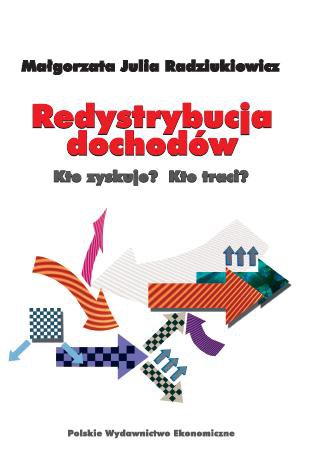Redystrybucja dochodów. Kto zyskuje? Kto traci?
Publication date: 2012
Place publication: Warszawa
Publication: I
Binding: paperback
Format: 162x237
The Author discussed the problem of income redistribution and its influence upon the level of consumption in households. Apart from concise consideration of theoretical issues she also presented the findings of her own independent research.
Redistribution is a secondary distribution of income of the society which includes financial flows performed as transfers among all players active in the market, and the state budget and budgets of local governments. The very process of redistribution takes place in several dimensions and consists in burdening the commercial activity and the income of all business entities with various types of taxes and fees which, taken together, make up the revenue to the state budget. Then that income becomes a source of financing those social groups which do not achieve income on performing work (e.g. unemployed, retired) or those goods that are rendered available to the society either free of charge or partially against payment (e.g. health service, defense, education, justice, state administration).
The issue of redistribution (secondary division) of income has become one of the most complicated problems as well as one of the key areas of state intervention.
From the point of view of national policy in the area of income redistribution the crucial ideological aspect is that of developing a set of specific criteria, reckoned fair, of dividing the goods among social groups and individual members of the society. In practice the issue of fairness mainly focuses upon economic criteria and is limited to material justice, while the most emphasis is put upon distributive justice. In general terms, fair distribution of resources consists in the choice between equality and effectiveness.
The issue of equality — equal welfare, on the par for everybody — is in most cases considered in the context of inequalities. A radical increase of economic disparities (social, political) in most cases leads to destabilization of social situation. Accordingly, the principal role of the state should be restriction of income inequalities and elimination — through tax and transfer mechanism — excessive income brackets.
In Poland significant differences in the income of households is experienced. Therefore, the key hypothesis is as follows: under the social policy run by the state, the division of income should aim at and achieve more uniform distribution, thus reducing the phenomenon of poverty.
SPIS TREŚCI
Wprowadzenie
1. Cel i zakres redystrybucji dochodów
1.1. Pojęcie dystrybucji
1.2. Redystrybucja dochodów
1.3. Główny dylemat podziału dochodów
1.4. Instrumenty redystrybucji
1.5. Pomiar skutków zmiany podziału dochodów
1.6. Przedmiot redystrybucji — dochody gospodarstw domowych
1.7. Powody i cele redystrybucji
1.7.1. Nierówność dochodów
1.7.2. Skala ubóstwa
1.7.3. Normy społeczne
2. Redystrybucyjne efekty transferów z pomocy społecznej
2.1. Uwagi wstępne
2.2. Wydatki państwa
2.3. Budżet socjalny
2.4. Beneficjenci środowiskowej pomocy społecznej
2.5. Wpływ pomocy społecznej na zróżnicowanie dochodów i zasięg ubóstwa gospodarstw domowych
2.5.1. Rodzaje otrzymywanej pomocy społecznej
2.5.2. Beneficjenci pomocy społecznej
2.5.3. Czy pomoc społeczna jest ukierunkowana na ludność ubogą?
2.5.4. Wpływ transferów z pomocy społecznej na zróżnicowanie dochodów i zasięg ubóstwa
2.6. Wpływ świadczeń edukacyjnych na zróżnicowanie dochodów gospodarstw domowych
2.6.1. Wysokość świadczeń edukacyjnych w gospodarstwach domowych
2.6.2. Redystrybucja świadczeń edukacyjnych
2.7. Podsumowanie
3. Redystrybucyjne efekty podatków pośrednich
3.1. Uwagi wstępne
3.2. Cel i rodzaje podatków
3.3. Dochody budżetu państwa
3.4. Obciążenie podatkami pośrednimi gospodarstw domowych w 2008 roku
3.4.1. Uwagi wstępne
3.4.2. Obciążenie podatkami pośrednimi wydatków gospodarstw domowych zależnie od ich grupy społeczno-ekonomicznej
3.4.3. Obciążenie podatkami pośrednimi wydatków gospodarstw domowych zależnie od typu rodziny biologicznej
3.4.4. Obciążenie podatkami pośrednimi dochodów gospodarstw domowych
3.4.5. Redystrybucyjne efekty podatków pośrednich
3.5. Podsumowanie
4. Wpływ redystrybucji na konsumpcję gospodarstw domowych
4.1. Uwagi wstępne
4.2. Dochody gospodarstw domowych
4.3. Współczesne przeobrażenia konsumpcji
4.4. Oszczędności gospodarstw domowych
4.5. Skłonność do konsumpcji
4.6. Wpływ obciążeń podatkami pośrednimi na konsumpcję gospodarstw domowych
Podsumowanie
Bibliografia
| Odbiór osobisty | 0 € |
| Inpost Paczkomaty | 4 € |
| Kurier Inpost | 4 € |
| Kurier FedEX | 4 € |
| Free delivery in Reader's Club | from 47 € |

